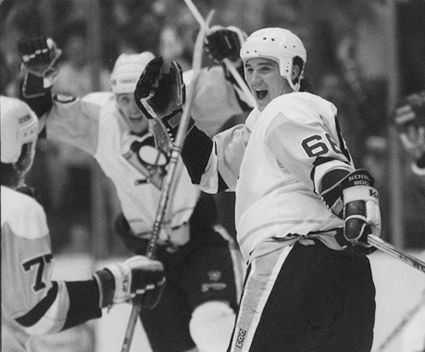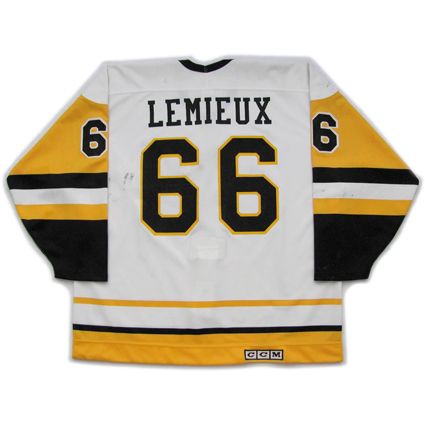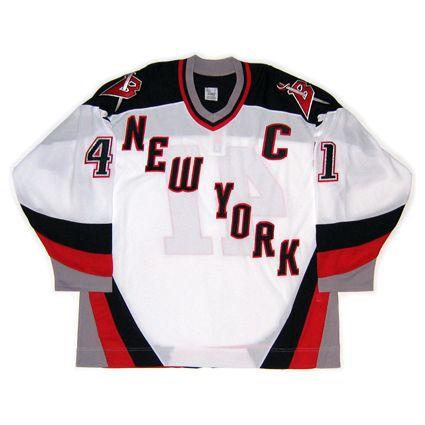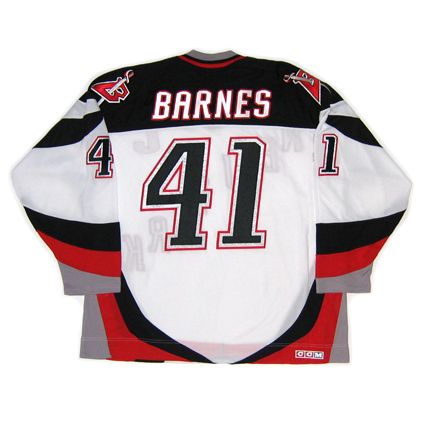Thursday, December 31, 2009
1988-89 Pittsburgh Penguins Mario Lemieux Jersey
In one of the most miraculous nights in NHL history, on this date, New Year's Eve in 1988, Mario Lemeiux of the Pittsburgh Penguins scored five goals - in five different ways!
Their opponents that night were the New Jersey Devils and Lemieux began is night in typical Lemieux fashion, skating down the right side and scoring an even strength goal at 4:17 of the first period to tie the score at 1-1.
His next goal came shorthanded, undressing Aaron Broten and deking Devils goaltender Bob Sauve for a goal at 7:50 with the Penguins a man down.
He was then set up on a power play by Paul Coffey at 9:46 with the Devils two men short, firing a one-timer for the hat trick, all in the first period.
With the Penguins being awarded a penalty shot after the second Devils goaltender of the game, Chris Terreri, threw his stick at the puck while in Lemieux's posession, Lemieux was naturally chosen to take the shot. He converted through Tererri's legs for his fourth of the game at 11:14 of the second, making him three for three in his career penalty shots at the time.
He concluded his magical evening with an empty net goal at 19:59 of the third, giving him five goals in five different ways, something likely to never be repeated any time soon, if ever.
Teammates celebrate Lemieux's spectacular performance
His fifth goal sealed the Penguins victory by a final score of 8-6 as Lemieux completed his eight point night, as he had already assisted on the three goals he didn't score!
Today's featured jersey is a 1988-89 Pittsburgh Penguins Mario Lemieux jersey. as worn on the memorable night during which he scored 8 points on 3 assists and 5 goals, each scored a different way.
This is the first and only year for this particular variation of the Penguins jersey, as the previous season the white sweaters had a gold collar for one season and the numbers were still located up on the shoulders. For 1988-89, the collar changed back to black and the numbers were moved down onto the sleeves, now contained inside the yellow area.
Soon afterwards this style Penguins jersey would undergo it's final changes, with the names on the back now being a sans-serif block font. In addition, the font for the numbers would change slightly, to a thicker font for the back numbers and the sleeve numbers getting noticeably more squarish when compared to the previous style.
Here they are, all five goals in five different ways on New Year's Eve in 1988.
Labels:
Lemieux,
Pittsburgh Penguins
Wednesday, December 30, 2009
1996 Sweden National Team Peter Forsberg Jersey
On this date in 1992, Peter Forsberg of Sweden set a record with 10 points in a single game as Sweden pummeled Japan 20-1 during the 1993 World Junior Championships in Gavle, Sweden.
The format for the tournament that season saw each of the eight teams play the other seven once in a round-robin format, with the top three teams at the completion of the schedule taking home the medals.
Of interest, Czechoslovakia divided into the Czech Republic and Slovakia during the tournament, but the Czechoslovakian team continued to play as one under the title of the Czech and Slovak Republics.
Play began on December 26, 1992 with Canada beating the United States 3-0, Finland downing Czechoslovakia 5-2, Sweden defeating Germany 4-2, and in a hint of what was to come, Russia demolished World Juniors debutants Japan by a score of 16-0.
The following day Japan was again shut out, this time by Finland by a more reasonable score of 7-0, while the host Swedes lost to Canada 5-4.
On December 29, Sweden thumped Czechoslovakia 7-2 and Japan broke their scoreless streak in a 12-2 loss to the United States.
The fateful matchup arrived on this date in 1992, as Sweden faced off against Japan, in a game that ended with a record setting 20-1 score in favor of Sweden. After giving up an average of 12 goals a game up to this point, no one expected much of the Japan-Sweden matchup, but it ended up being the largest victory for Sweden in the history of the tournament, the second most goals ever scored by a team in a game, only 1 behind the record held by Czechoslovakia since 1981.
The game also propelled Forsberg to the record for most points in a game with 10, the most assists by a player in one tournament with 24 and most points by a player in one tournament with 31, most points by a line in one tournament with 69, a mark he shares with Markus Naslund and Niklas Sundstrom, the most all-time assists, with 32, and points in World Junior history with 42.
Naslund also holds the record with 13 goals in one tournament, all thanks in large part to the 20-1 demolition of Japan, who were not surprisingly relegated back to the B Pool for the 1994 tournament after finishing with a 0-7 record with 9 goals for and 83 against. Yes, that is not a typo - eighty-three goals against, following subsequent defeats by the newly re-christened Czech and Slovak Republics on January 1 by a score of 14-2, losing to Canada by a surprisingly reasonable 8-1 and finally losing to Germany 6-3 for the Germans only win of the tournament.
Canada lost on the final day of the tournament 7-4 to the Czech and Slovak Republics, but still earned the gold medal thanks to owning the tie-breaker with Sweden, having defeated them 3-2 in their head-to-head matchup earlier in the tournament.
While Japan was soundly thrashed at the 1993 World Juniors, it was not their worst defeat in international competition. That came in a 25-1 loss to Czechoslovakia at the World Championships in 1957. Don't feel too badly for Japan however, as their greatest triumph occurred in 1999 at the Asian Winter Games when they defeated Kuwait, who making their international debut, by a resounding 44-1.
Forsberg would go on to become a member of the prestigious "Triple Gold Club", having won the World Championships, the Olympics and the Stanley Cup, three titles he has actually won twice each.
Today's featured jersey is a 1996 Sweden National Team Peter Forsberg jersey from the 1996 World Cup of Hockey. Sweden would win the European pool with a 3-0 record, defeating Finland, Germany and the Czech Republic, before losing 3-2 to Canada in two overtimes in the semi-finals.
This jersey features the large 4" diameter 1996 World Cup of Hockey patch worn by all the Bauer supplied teams in the tournament, which also included Canada and the Czech Republic. The remaining teams, the United States, Russia, Slovakia, Finland and Germany all wore Nike jerseys which sported the same patch, only in a 3" size.
Here are the Top 10 rivalry moments between Canada and Sweden in international hockey history, with a memorable appearance by Peter Forsberg.
Next, the fine, fine acting skills of Forsberg are on display for your viewing pleasure.
Labels:
Forsberg Peter,
Sweden,
World Junior Championships
Tuesday, December 29, 2009
1993-94 University of Minnesota Duluth Chris Marinucci Jersey
Born on this date in 1971, Chris Marinucci attended the University of Minnesota Duluth beginning with the 1990-91 season. He started slowly, as most college players do getting used to the size and speed of the college game, with 16 points in 36 games in his first season and 19 in his second.
1992-93 was his breakout season in college, seeing his goal total leap from 6 in each of his first two seasons to 35 as a junior, combined with 42 assists for 77 points, an increase of 58 from the year prior, ranking him second in the WCHA and 8th nationally and helping the Bulldogs win the WCHA regular season title.
1993-94 saw another 30 goals plus 31 assists for 61 points for Marinucci who led the Bulldogs in scoring that season. He was named both the WCHA Most Valuable Player and the 1994 Hobey Baker Award winner, given to the top player in college hockey each season. Throughout his college career, Marinucci played in 149 consecutive games.
Marinucci would turn pro the following season, spent primarily with the Denver Grizzlies of the IHL, scoring 69 points in 74 games. Following the regular season he would add 7 points in 14 games as Denver would sweep the Kansas City Blades for the Turner Cup, awarded to the champions of the IHL each season. Marinucci would also make his NHL debut with the New York Islanders, seeing action in 12 games which included scoring his first and only NHL goal.
He would only see action in eight games due to injuries in 1995-96 with the relocated Utah Grizzlies, forced to move from Denver with the arrival of the Colorado Avalanche. He would see plenty of action with a full season of games in 1996-97, split between one game with the Los Angeles Kings, 21 games with the Grizzlies plus 62 games with the Phoenix Roadrunners, also of the IHL. He would score 52 points in his 62 games in Phoenix. Marinucci would also skate for the United States at the 1997 World Championships, scoring a goal in 8 games.
The next three seasons were spent playing for the Chicago Wolves on the IHL where he would put up fine numbers. 1997-98 was good for 75 points in 78 games and the Wolves would defeat the Detroit Vipers 4 games to 3 to capture his second Turner Cup.
1998-99 followed with career highs with 41 goals and 81 points in 82 games. In addition Marinucci was named the IHL Man of the Year. Another 31 goals and 64 points followed in 1999-00 along with another Turner Cup by defeating the Grand Rapids Griffins 4-2 in the finals before Marinucci would begin racking up the frequent flyer miles.
His first stop on his world tour was Kokudo of the Japan League. Marinucci would score 29 goals and 59 points in 40 games as the Rabbits would capture the championship.
2001-02 saw a move to the Berlin Polar Bears of the German DEL with 36 points in 53 games while 2002-03 was split between the Idaho Steelheads of the WCHL and IF Björklöven of the second division in Sweden.
His career would wind down in 2003-04 with more games in Idaho as well as with the Storhamar Dragons of the Norwegian Elite League, which included 17 regular season games and 13 playoff games en route to yet another championship for Marinucci and a nice way to conclude one's career.
While his number of NHL games were limited, he did play in 405 games in the IHL, scoring 157 goals and 365 points and a trio of Turner Cup Championships as well as titles in Japan and Norway.
Today's featured jersey is a 1993-94 University of Minnesota Duluth Bulldogs Chris Marinucci jersey. This beautiful jersey holds the record for the longest project from start to finish in the history of the Third String Goalie Collection, as we originally purchased the shoulder patches for this jersey back in 1987.
Only recently were we able to complete the project after 22 years now that this jersey has been made available by VintageMinnesotaHockey.com topped off perfectly by our pair of skating Bulldog patches purchased at a game in Duluth all those many years ago with the hopes of some day being able to have this classic looking jersey reproduced.
Will the wonders of YouTube never cease? Of all the unexpected things we've ever found this one probably tops them all - an interview with a newly arrived Marinucci prior to his first game with IF Björklöven in Sweden.
We are literally dumbstruck.
So, how did the big game against those bastards from Skellefteå turn out? Seems like the good guys won, but if you watch this video you will get see a hot babe and some sausages. Promise.
Speaking of Björk loving, when was the last time you saw anyone play a table full of wine glasses? Now that is seriously unplugged.
Monday, December 28, 2009
1984 Team Canada Ray Bourque Jersey
Born on this date in 1960, Ray Bourque played 21 seasons in the NHL and currently holds the records for most goals, assists and points by a defenseman in league history.
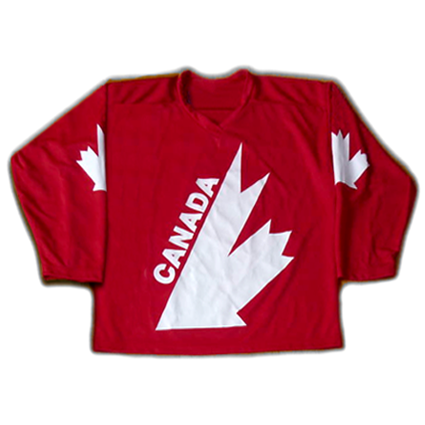
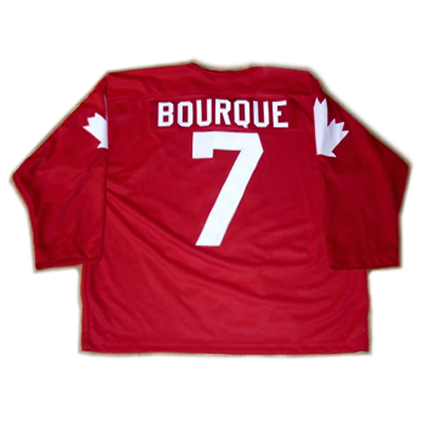
He won the Norris Trophy five times and capped off his career by winning the Stanley Cup in the final game he ever played. His jersey #77 has been retired by both his long time club the Boston Bruins, as well as the Colorado Avalanche, with whom he won the Stanley Cup.
With the World Junior Tournament now taking place, we thought it would be appropriate to take a look back at the international career of Bourque.
He first appeared for Team Canada in the 1981 Canada Cup as a 20-year-old after only two seasons in the NHL and took home a silver medal while contributing 1 goal and 4 assists in 7 games while wearing sweater #8.
He also skated in the 1984 Canada Cup, scoring 4 assists in 8 games. Canada emerged victorious after defeating the Soviet Union 3-2 in overtime before capturing the title by defeating Sweden in the best of three finals 2-0 by scores of 5-2 and 6-5.
Bourque was a member of the NHL All-Star squad that took on the Soviet Union in Rendez-vous '87, a two game series that took the place of the usual NHL All-Star Game that year and scored a goal in Game 2.
His final Canada Cup appearance was in 1987 and was an assistant captain of the squad and again wore #7. Canada defeated Czechoslovakia 5-3 in the semi-finals and won a thrilling best of three final over the Soviet Union after losing Game 1 in overtime 6-5. Canada avoided elimination by taking the Soviets by an identical 6-5 score, only this time in two overtimes. The final game was a nail-biter, with Canada winning by yet another 6-5 score on a goal with just 1:26 remaining in the game. Bourque would finish the tournament with 2 goals and 6 assists for 8 points in 9 games played, good for sixth overall and first among defensemen.
The 1998 Winter Olympics in Nagano, Japan was Bourque's final tournament for Team Canada, where he contributed 1 goal and 2 assists in 6 games.
Today's featured jersey is a 1984 Team Canada Ray Bourque jersey. This jersey is remarkable in it's stark simplicity, with it's one color crest, lacking even sleeve numbers.
Bourque wore #8 during the 1981 tournament and the "A" as assistant captain in 1987 In addition, all players wore Labatt Canada Cup patches on their right chest during the 1987 and 1991 tournaments, making this configuration of Team Canada Bourque jersey unique to the 1984 tournament.
This basic jersey style was used by Canada in all the Canada Cups, starting in 1976 through the final one in 1991, with it's main crest mimicking the Canada Cup trophy, which was not really a "cup" in the proper sense.


Here are the goals from the dramatic final game of the 1987 Canada Cup. Careful viewing will confirm #7 Bourque playing in the game on a couple of occasions. Don't be fooled by #77 Paul Coffey.
Labels:
Bourque Ray,
Canada
Sunday, December 27, 2009
1995-96 Colorado Avalanche Joe Sakic Jersey
On this date in 1999, Joe Sakic of the Colorado Avalanche scored his 1,oooth career point with an assist in a 5-1 win over the St. Louis Blues in Colorado.
Sakic was originally drafted by the Avalanche franchise when they were still the Quebec Nordiques 15th overall in the 1987 NHL Entry Draft.
A little known fact is that Sakic's parents were Croatian immigrants and he grew up speaking Croatian before attending elementary school. He would be named Rookie of the Year in the Western Hockey League of Canadian Juniors in 1987 after scoring 133 points. He also survived a horrific bus crash involving his club, the Swift Current Broncos, in which four of his teammates were killed. The following year Sakic was named WHL Most Valuable Player and Canadian Major Junior Player of the Year after scoring 160 points.
He scored an assist on his NHL debut on October 6, 1988 versus the Hartford Whalers and originally wore sweater #88 because Alain Cote was wearing his preferred #19. He finished with 62 points in 70 games although the Nordiques finished in last place overall in the NHL, which allowed the to select Swede Mats Sundin first overall.
With Cote now retired, Sakic claimed his #19 for 1989-90 and scored 102 points but the Nordiques sank to the depths of the NHL, finishing a distant last in points, 33 points behind the second worst club, with Owen Nolan being the prize that awaited them at the 1990 draft.
1990-91 saw Sakic score 109 points, sixth overall in the league, and be named co-captain of the Nordiques (for home games). Yet another last place finish by the Nordiques, this time by 11 points, put them in position to draft Eric Lindros, despite Lindros' adamant refusal to play for the Nordiques.
Sakic would miss 11 games in 1991-92, which would hurt him in his chances to repeat another 100 point season, and he would conclude the year with 94 points. The Nordiques managed to finish next to last in the standings. Unfortunately, they did not pass any clubs ahead of them from the season before, but "moved up" from last by finishing ahead of the expansion San Jose Sharks in their debut season. While first round draft pick Todd Warriner would never skate for Quebec, being involved in a later trade along with Sundin that would bring in Wendel Clark and Sylvain Lefebvre, the off-season trade of the holdout Lindros for a king's ransom would send the Nordiques on the path to competitiveness, as they would receive goaltender Ron Hextall, Steve Duchesne, Kerry Huffman, Mike Ricci, Chris Simon, future star Peter Forsberg, a pair of first round draft picks in 1993 and 1994 along with a cool $15 million.
Now named full time team Captain of the newly reconfigured Nordiques, Sakic would respond in 1992-93 with 105 points and lead the Nordiques out of the wilderness and into the playoffs for the first time in his career on the heels of a staggering 52 point improvement, double their total of the year prior. Without any previous playoff experience, the Nordiques would be eliminated in the first round by arch-rivals the Montreal Canadiens. The process of building the Nordiques took another step forward by picking both goalie Jocelyn Thibault and Adam Deadmarsh in the first round of the draft.
1993-94 was a slight step back for Sakic, as he would fall short of the 100 point barrier with 92, but the Nordiques would take a large step back, dropping 28 points in the standings and miss the playoffs yet again.
The Nordiques final season of in Quebec saw Sakic finish fourth in scoring during the lockout shortened 1994-95 season and the Nordiques would capture the division title, only to be eliminated in six games by the New York Rangers, ending their time in Canada.
Relocated to Denver, the Colorado Avalanche took to the ice in the 1995-96 season hoping to continue the improvement shown during Sakic's seven seasons in Quebec. Little did anyone anticipate the events that would unfold that season.
After having a major falling out with the Montreal Canadiens, superstar goaltender Patrick Roy was traded to the Canadiens former arch-rivals, now located in Colorado, a trade which would have never, ever happened had the club remained in Quebec. In addition to receiving Roy, veteran Mike Keane would arrive in exchange for Thibault, Martin Rucinsky and Andrei Kovalenko, and the Avalanche were on their way.
Sakic topped 50 goals for the first time with 51, adding 69 assists for a career high 120 points for third in the league. The Avalanche would storm the playoffs, defeating first the Vancouver Canucks, followed by the Chicago Blackhawks by identical 4 games to 2 margins. Next up was a hard fought series with the Detroit Red Wings, upsetting the team that finished 27 points ahead of them in the standings 4-2 for the right to face the upstart Florida Panthers, whom they easily dismissed in four straight games for the the franchises first Stanley Cup Championship in their first season out of Quebec. Sakic would lead the playoffs in scoring that season and be named the winner of the Conn Smythe Trophy.
It had been a long journey for Sakic, who, along with Curtis Leschyshyn, were the only two Nordiques players from the 1988-89 season to suffer through the years of last place finishes to eventually raise the Stanley Cup.
Sakic would eventually play 13 seasons in Colorado, scoring 100 points twice more in his career, eventually hitting the 1,000 point mark on this date in 1999. The Avalanche were regular fixtures in the playoffs, and contenders for the Stanley Cup for seven straight seasons, reaching the conference finals in six of those seven seasons, including winning the Stanley Cup again in 2001.
Today's featured jersey is a Starter 1995-96 Colorado Avalanche Joe Sakic jersey and features the 1996 Stanley Cup Finals patch. This jersey stands apart with it's "mountain range" striping on the waist and arms, unlike any other jersey of it's day. Combined with it's unique color palette, custom number font, memorable secondary shoulder logos and the club's success on the ice, this style Colorado Avalanche jersey is a true icon of it's era and only the change to the templated Reebok Edge jerseys killed off what would have likely been one of those jerseys that lived on unchanged for years.
The white names and numbers on this jersey have a textured herringbone pattern pattern to them, which is called "Glacier Twill". In addition to that detail, the silver outline around all the numbers is a metallic silver material, which is often done as a flat grey material on Avalanche jerseys. The lettering for the name is also tall and narrow, as shown by the shape of the "C", which is also often found as a nearly perfect circle shape with rounded, instead of flat sides like shown here.
Our featured video today are the Top 10 Joe Sakic Moments from his throughout his career.
Labels:
Colorado Avalanche,
Quebec Nordiques,
Sakic
Saturday, December 26, 2009
1978 Team Canada Wayne Gretzky World Juniors Jersey
The 2010 IIHF World Under 20 Championship kicks off today in Regina and Saskatoon, Saskatchewan in Canada with four games, as the Czech Republic takes on Sweden at 1 PM Central Standard Time in Regina. Games later today include hosts Canada vs. Latvia at 3 PM, Russia vs. Austria at 5 PM and Slovakia against the USA at 7 PM, a game which can be viewed in the US on the NHL Network, whose complete schedule can be seen here. Fans in Canada can view the TSN schedule of games here.
The NHL Network will air 16 games, including all the USA games in the preliminary round, plus six additional games. They will then feature all six medal round games, with the quarterfinals on January 2nd, the semifinals on 3rd and both the Bronze and Gold Medal Games on January 5th.
The countries competing this year are; Group A - Canada, Slovakia, USA, Latvia and Switzerland. Group B, the "Group of Death", comprises Sweden, Russia, Czech Republic, Finland and Austria, with only the top three from each group advancing to the Medal Round elimination playoffs.
Meanwhile, the bottom two teams in each group are sent to the four team Relegation Round. When completed, the two bottom teams will be relegated down to the Division 1 level and replaced in the 2011 tournament by Germany and Norway, who earned promotion to the Top Level with victories in the Division 1 Groups A and B earlier this year.
Anyone who is anyone in the NHL has participated in the World Juniors, including the likes of Viacheslav Fetisov, Wayne Gretzky, Jari Kurri, Igor Larionov, Mario Lemieux, Steve Yzerman, Esa Tikkanen, Brian Leetch, Alexander Mogilny, Sergei Fedorov, Jeremy Roenick, Mike Modano, Pavel Bure, Jaromir Jagr, Eric Lindros, Ziggy Palffy, Scott Neidermayer, Alexi Kovalev, Peter Forsberg, Markus Naslund, Paul Kariya, Jarome Iginla, Miikka Kiprusoff, Marian Hossa, Daniel Sedin, Henrik Sedin, Simon Gagne, Henrik Lundqvist, Zach Parise, Marc-Andre Fleury, Ryan Getzlaf, Jeff Carter, Alexander Ovechkin, Dion Phaneuf, Sidney Crosby, Evgeni Malkin, Phil Kessel, Nicklas Backstrom, Patrick Kane, Jonathan Toews, Carey Price and most recently, John Tavares. You may not know the top players in this year's tournament now, but rest assured, you will soon enough.
The "World Juniors" were first held in 1977 after three years of unofficial events, all won by the Soviet Union, and are particularly popular in Canada, where they are treated as practically a 11 day national holiday.
The original tournament was hosted by Czechoslovakia, which saw the Soviet Union capture the first of four consecutive championships. Sweden broke the Soviet stonghold on the title by winning in 1981 in West Germany, while Canada captured their first gold the following year in the United States before the Soviets put together a pair of back to back championships in 1983, becoming the first host to win, and 1984.
After wins by Canada and the Soviet Union, Finland broke through to take their first title in 1987 when the infamous "Punch-up in Piestany" occurred, as a 20-minute bench clearing brawl between the Canadians and Soviets broke out, which led to the arena lights being turned off in an attempt to restore order and both Canada and the Soviet Union expelled from the tournament as a result.
The event spawned our all-time favorite hockey quote ever:
"You don't like to see 20 kids punching 20 other kids.
It's not a disgrace. It's hockey." - Michael Farber.
Canadian fans might also enjoy reading Red, White, and Gold: Canada at the World Junior Championships 1974-1999 by noted hockey author Andrew Podnieks.
Canada returned to the top in 1988 in Moscow, followed by the Soviets in 1989. Canada went on a tear and captured seven of the next eight tournaments from 1990 to 1997, with only the Soviet Championship in Germany in 1992 breaking the Canadian domination. Oddly, the Canadians did not even medal that year.
Then, a most unusual thing happened. Finland took it's second and most recent title in 1998, followed by the first for Russia in 1999 before the Czech Republic captured not one, but it's first two titles in a row in 2000 and 2001.
Russia won back to back in 2002 and 2003 followed by the United States winning it's first World Juniors in 2004 in Finland, making for seven straight years without gold for Canada.
The Canadians rebounded, starting with the Dream Team in 2005, a roster loaded with future NHL talent, aided in part by the availability of some players due to the 2004-05 NHL Lockout. Their domination of the tournament in Grand Forks, North Dakota kicked off a run of titles that now stands a five consecutive, a streak they will be looking to extend on home ice in this year's tournament.
The championship titles currently stand at 15 gold medals for Canada, 12 for the Soviet Union/Russia, two each for Finland and the Czech Republic and one for Sweden and the United States. The Soviet Union/Russia leads all medals with 28 to Canada's 25 with silver and bronze included in the totals. The only other countries to medal outside the six who have already won gold are Switzerland and Slovakia with one bronze each in 1998 and 1999 respectively.
The host country has won in 1983 (Soviet Union), 1991, 1995, 2006 and 2009 (Canada) and 1998 (Finland) - just six out of 33 tournaments.
With sparse attendance frequent at nearly all venues not in or near Canada, the Canadians have become more and more frequent hosts, as they hosted 1 out of the first 9 tournaments, but will now host three out of four between 2009 and 2012, with the other taking place on the Canadian border in Buffalo, New York in 2011, no doubt repeating the sea of waving maple leaf flags seen in Grand Forks, North Dakota in 2005 when we at Third String Goalie were in attendance.
In honor of this year's host, today's featured jersey is a 1978 Team Canada Wayne Gretzky World Juniors jersey worn by Gretzky as a 16-year-old when he led Team Canada in scoring and was named Best Forward in the tournament while Canada took home the bronze medal.
For some reason unknown to us, Canada opted for a white home jersey with a blue Maple Leaf design and blue numbers on the back, adorned with a red maple leaf on each arm, and even more oddly, a blue road jersey with a white logo and numbers, also adorned with the same red maple leaves on each arm. The red maple leaf on the blue background is especially low contrast and would have clearly benefitted from being outlined in white, or more obviously been improved by being a white leaf on a proper red jersey!
First up in today's video section is a 16 year old Wayne Gretzky being interviewed at the 1978 World Juniors while wearing today's featured jersey.
Let's take a look back at the Top 10 Moments from the Canadians recent five year winning streak.
Now that you've seen the Top 1o moments from the last five years, let's focus on last year's tournament, which included an escape by the Canadians with mere seconds remaining against Russia in the semi-finals.
Here is the infamous 1987 brawl in Piestany which got both the Canadians and Soviets expelled from the tournament, costing the Canadians a medal.
Labels:
Gretzky,
World Junior Championships
Friday, December 25, 2009
2001-02 Buffalo Sabres "New York" Stu Barnes Jersey
Merry Christmas!
We have two posts today, so after today's usual "jersey o' the day" post about the life and times of Stu Barnes, be sure to scroll down to our special hockey holiday video selections, which have a little something for everyone!
********************
Born on Christmas Day in 1970, Stu Barnes was drafted 4th overall in the 1989 NHL Entry Draft by the Winnipeg Jets while in the process of scoring 389 points in 204 games during his three seasons in the Canadian junior Western Hockey League.
He would make his NHL debut with Winnipeg in the 1991-92 season and score his first NHL goal, along with 7 more, plus 9 assists for 17 points in 46 games that season.
His time in Winnipeg was short-lived however, as he was traded to the Florida Panthers. He would spend parts of four seasons in Florida, highlighted by their run to the Stanley Cup Finals in 1996. Barnes would contribute to the playoff run with 16 points in 22 games during "The Year of the Rat".
During the 1996-97 season, Barnes was dealt to the Pittsburgh Penguins. His offensive numbers would take a leap upwards in his new environment, and he would set career highs in 1997-98 with 30 goals and 35 assists for 65 points. He would never exceed 20 goals in any other of his 16 seasons in the NHL.
The following season Barnes was once again moved, this time to the Buffalo Sabres in exchange for Matthew Barnaby. While he only played in 17 regular season games that season for the Sabres, he was with them all the way throughout the playoffs, totaling 21 games, which included 7 goals and 3 assists as the Sabres made it all the way to the Stanley Cup Finals.
He was named team captain for the Sabres at the start of the 2001-02 season, during which today's featured jersey was worn following the terrorist attacks on September 11th.
Barnes popularity with the Sabres fans during his five seasons in Buffalo was aided by the calls of announcer Rick Jeanneret's calls of "Stuuuuuuuuuuuu Barnes!" following his goals. However, the last place Sabres began a rebuilding process in 2002-03, which including trading team captain Barnes to the Dallas Stars.
A steady and reliable performer in Dallas, Barnes would play an average of 79 games in the final four seasons of his career, scoring 11, 15, 13 and 12 goals in each season.
He would retire following the 2007-08 season with 1136 games played with 261 goals and 336 assists for 597 career points.
Today's featured jersey is a 2001-02 Buffalo Sabres "New York" Stu Barnes jersey. This jersey features Barnes' captain's "C" as well as the special "New York" cresting, which replaced the normal Sabres logo for this one game only.
The highest bids were $20,010 for Mark Messier's Rangers jersey, $15,010 each for Mike Richter and Brian Leetch of the Rangers, $9030 for Theo Fleury's Rangers jersey and $8030 for Eric Lindros of the Rangers with the highest Sabres jersey being Barnes at $5885. In total, 44 jerseys were auctioned off and over $215,000 was raised.
This is one of the more unique jerseys in the Third String Goalie collection. A blank Sabres CCM was first purchased. After locating the proper Sabres shoulder patches on ebay, the jersey was then sent in for customizing, with not only Barnes name and number, but the "New York" cresting recreated in the same font at the Sabres names on the back.
Here is a brawl from the October 7th, 2001 game when the Sabres and Rangers wore their special "New York" jerseys. You can see the Sabres jersey at the start before the players tie up. The 9/11 memorial ribbon patch can clearly be seen on the Rangers player's shoulder during the fight and you do get a clear look at both fighters jerseys at the end of the video when the fight is broken up and they are leaving the ice.
Plus, any day we get to post a video featuring Sabres announcer Rick Jeanneret is a good day.
Just because we can, some more Rick Jeanneret excitedly calling a few goals by Stuuuuuuuuuuuu Barnes!
Labels:
9/11,
Barnes,
Buffalo Sabres
Subscribe to:
Comments (Atom)

